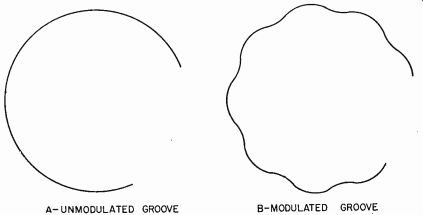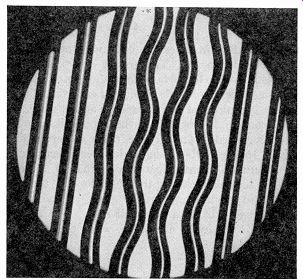DISC recording involves the engraving of a spiral groove in a flat disc of semisoft material. The groove is a precise spiral during periods of no modulation; but when an audio signal is recorded, the path of the groove varies from side to side in accordance with the positive and negative variations of the impressed audio. Fig. 101 shows a portion of one groove. In Fig. 101-a the groove is unmodulated-no signal has been recorded. The groove takes a perfectly spiral path around the disc. In Fig. 101-b a signal has been recorded. The path of the groove fluctuates from side to side (that is, laterally) within narrow limits, in accordance with the signal. (In the drawing, the lateral variations are much exaggerated.) Fig. 102 is an actual micro photograph of a small area of a recorded disc. The 3 wavy grooves are recordings of a 1,000-cycle sine wave, while the 2 at each side are unmodulated grooves.
A-UNMODULATED GROOVE; B-MODULATED GROOVE

Fig. 101 Grooves without signal recorded; b-with signal recorded.
In playing back, the phono pickup needle, traveling in the groove, is deflected from side to side by the variations in the groove path. This lateral movement is translated by the pickup into an audio voltage corresponding to the fluctuations.
This recording method is known as lateral recording because the groove varies in a lateral direction. There is a second method, vertical or "hill and dale" recording, so called because the variations occur in a plane vertical to the disc surface. In this system, audio fluctuations vary the depth of the engraved groove rather than its lateral path, which remains a perfect spiral throughout. The early Edison records were recorded by the vertical method, and today many broadcast transcriptions are made in this manner because of certain inherent advantages.

Fig. 102--Actual micro-photo of grooves with and without modulation.
Vertical recording being confined to a very few large transcription manufacturers and the equipment not being generally available, we will confine ourselves to lateral recording.
The elements necessary to produce a lateral disc recording are:
1. A flat disc with a surface suitable for engraving;
2. An engraving tool or point (the stylus);
3. A means of converting electrical energy into mechanical movement of the engraving tool (a cutter or cutting head);
4. A means of rotating the disc under the engraving tool (motor and turntable);
5. A method of moving the engraving tool slowly and uniformly along the radius of the disc, to produce the spiral feed;
6. An amplifier to supply audio power to the cutter.